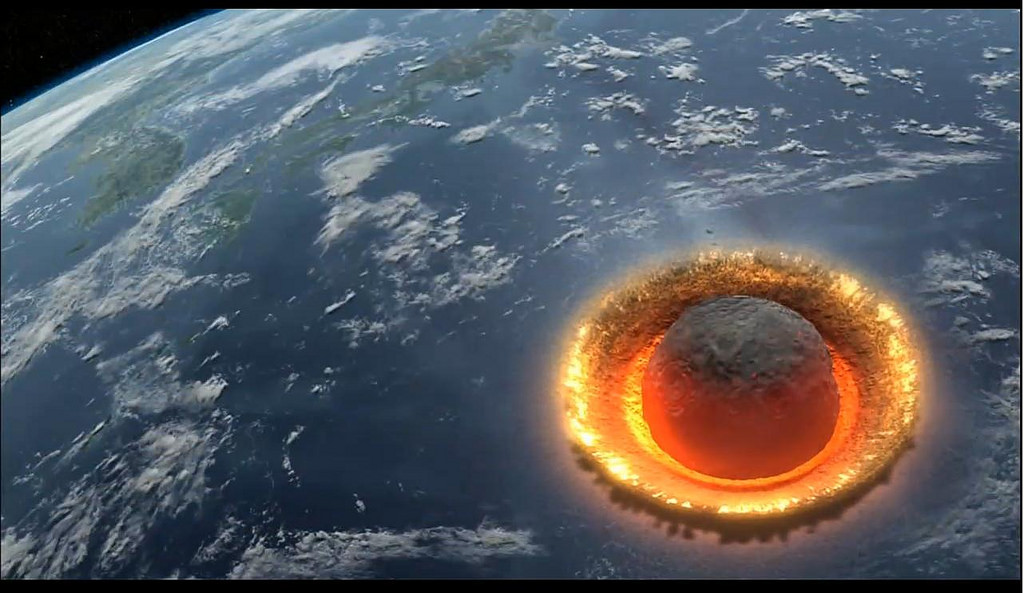Winging its way in at 70 km per second from somewhere in the asteroid belt, the meteorite, at 15 km in diameter is the largest and deadliest object to ever strike Earth. At ground zero the destruction is unimaginable, as a concentric shock wave propagates outwards at supersonic speed for a distance of over 300 km. The ground heaves, and where there was once solid rock, now there is molten glass, where there was once stable atmosphere, there is now a column of dust and ejecta towering thousands of metres into the afternoon sky. Ejecta and ash billow in vast, debris laden clouds, casting a doom-black pall across the land. The sun, as if bending down to look onto the face of the Earth, gazes impassively at her blighted face, while hot winds toss the dark clouds across the crimson disk before going out with the light.

Wandering through the long grass around the village of Vredefort, Free State, South Africa, the casual observer would not have the slightest inkling that this is Ground Zero of the largest meteorite impact on Earth. Low quartzite ridges provide the topographical interest with valleys in between. From the air the picture becomes somewhat clearer; as a series of concentric topographic ridges with intervening valleys become apparent, best developed in the northwest of the area. In geological parlance this is a “dome” – an approximately circular area of Earth’s uplifted crust, dipping away from the centre, and in our case 80 km in diameter.
At Vredefort the layers of the cake are stood on end
To explain the enormity of this event a little stratigraphy is necessary at this point and perhaps a good analogy is a multicoloured cake. The adventurous chef has placed pink sponge at the base, and then covered it with alternating layers of chocolate and vanilla sponge. The pink represents the ancient granite which underlies 1000’s of square kilometres of real estate around the dome, and the alternating coloured sponge layers, the younger sedimentary cover. At Vredefort the layers of the cake are stood on end, with the pink granite sponge protruding through the overlying layers. Returning to the scale of the real world, this is the equivalent of 20 km thickness of rock being upturned and the granite punching through to the surface. This is, to use an overused but appropriate word, awesome.
Shatter cones and spectacular fracturing
Back on the ground, evidence of some kind of cataclysmic event having occurred here is to be found in the form of two rock types known as pseudotachylite and granophyre. Shatter cones and spectacular fracturing of the rocks also bare witness to this event. Tachylite is a form of glass found in volcanic environments, which the material in the dome resembles, although this is clearly not a volcanic environment, hence the prefix ‘pseudo’. Pseudotachylite is almost ubiquitous throughout the dome and occurs in veins from less than 1 mm to up to 100 metres thick.
The result of the almost instantaneous shock wave so intense as to shatter and melt hard, competent rock.
The Vredefort granophyre, a brecciated rock, meaning all smashed up, has as part of its composition a glassy matrix indicating instant melting and rapid cooling. In fact both of these rock types are the product of shock-induced melting. The granophyre occurs as large dykes, several kilometres long and many metres wide with a composition different to any other known rock and containing fragments of extraterrestrial material. Then there are the shatter cones – concentric, conical structures the result of the almost instantaneous shock wave so intense as to shatter and melt hard, competent rock. And in the process to overturn a thickness of 20 km of granite.
Declared a World Heritage Site
The 80 km diameter of the dome represents only the uplifted, central part of the impact crater and by extrapolating from other known impact craters on the Earth and the moon, a figure of 300 km diameter for the Vredefort crater is arrived at – the largest impact crater on Earth. As a student in the late 1980’s there was much speculation as to its origin, and geologists, being essentially romantics at heart, adopted the meteorite impact theory. However, absolute, conclusive evidence was lacking but thanks to the careful work of Uwe Reimold and his team from the University of the Witwatersrand, conclusive evidence was provided to sustain this theory, enough for it to be declared a World Heritage Site in 2005, as Earth’s oldest and largest meteorite impact crater. How old is it? Just over 2 billion years, which is just under half the age of Earth. Fortunately life was still in its infancy then and the impact, although cataclysmic, did not cause the damage that better known and more recent collision events had on the biosphere.

